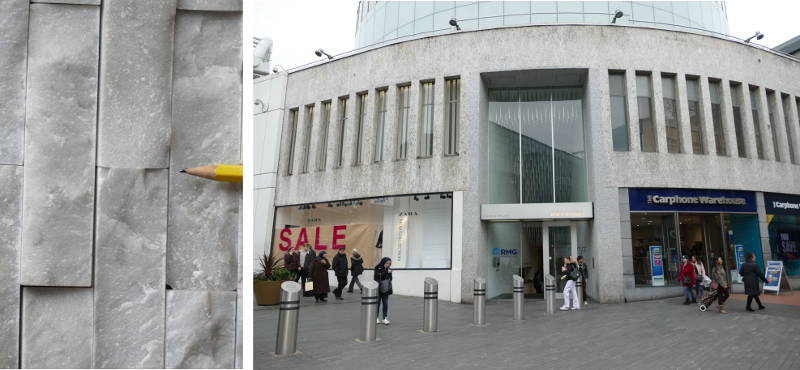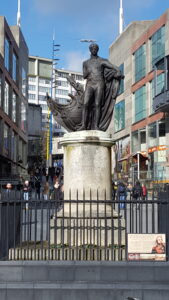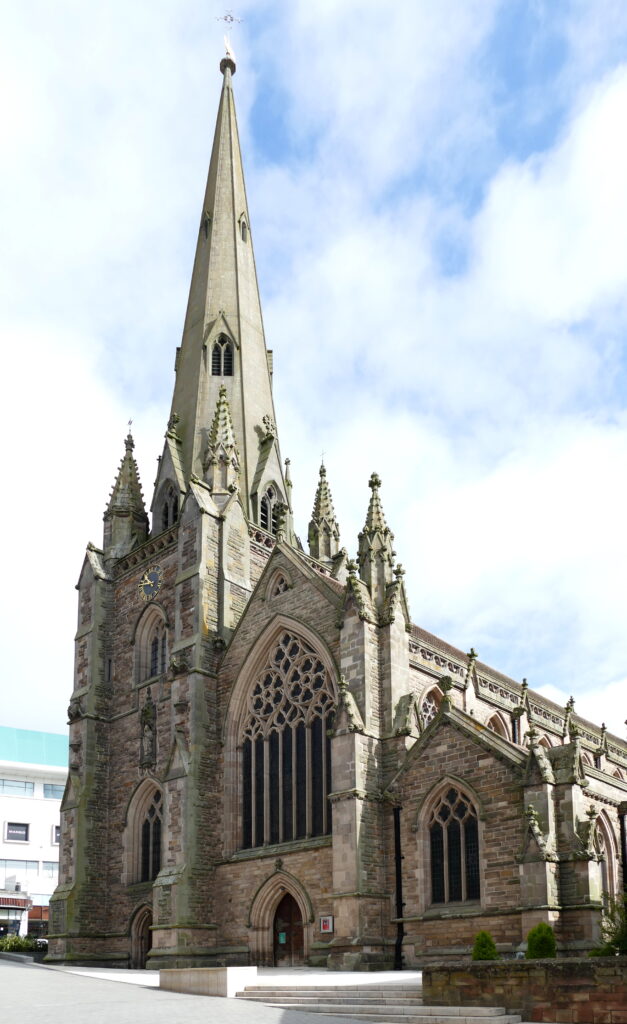Birmingham Building Stones Trails
References cited in the text are listed at the end of the trail. Hover over words in red (or click if you have no mouse) to see a definition (usually taken from Wikipedia). The stone varieties shown in green in the trail text can be found in our Index of Stones. The index also shows some of the buildings where the stones can be found and gives reference information about the stones.
Trail 3: Around the Shops
 The name ‘Birmingham’ is derived from the Anglo-Saxon Beormingahām, alluding to the home of the Beormingas clan and their settlement here was probably established as early as the 7th Century A.D. However the centre remained a poor region until the later 12th Century when Peter de Bermingham, local lord of the manor, developed a market centre around his castle, in the area that is now the Bull Ring. From then Birmingham’s economy began to take off and it became established as a small market town. The Bull Ring has also been shown to be an area of light industry at this time. Archaeological excavations carried out during the latest phase of construction in the early 2000s have revealed evidence of potters’ workshops and leatherworks during the 13th Century.
The name ‘Birmingham’ is derived from the Anglo-Saxon Beormingahām, alluding to the home of the Beormingas clan and their settlement here was probably established as early as the 7th Century A.D. However the centre remained a poor region until the later 12th Century when Peter de Bermingham, local lord of the manor, developed a market centre around his castle, in the area that is now the Bull Ring. From then Birmingham’s economy began to take off and it became established as a small market town. The Bull Ring has also been shown to be an area of light industry at this time. Archaeological excavations carried out during the latest phase of construction in the early 2000s have revealed evidence of potters’ workshops and leatherworks during the 13th Century.
This building stone trail focuses on the old centre of Birmingham, around the church of St Martin in the Bull Ring and the surrounding shopping malls. The area demonstrates continuity as a centre for trade and retail but the building materials used here have changed beyond those that would have been familiar to Peter de Bermingham and his family. The area has been transformed over the last two decades, and though the oldest part of the city of Birmingham, it is now the symbol of a new vibrant centre, with the covered markets replaced by glamorous shopping malls. Malls are modern cathedrals in terms of delivering the double whammy of decorative stones and public access. They are built to impress and the polished surfaces provide excellent opportunities for observing fossils, minerals and textures. This walk will take in the new shopping precincts of the Bullring and Grand Central as well as the surrounding retail areas. From stop 7 (New Street Station Concourse), there is an optional detour to Holloway Circus to visit the Pagoda.
The main source on the architecture of the buildings visited, unless otherwise cited, is Pevsner’s Architectural Guide to Birmingham (Foster, 2007). Information on public artworks is largely derived from Noszlopy & Waterhouse (2007). This is the third and final trail in the series ‘Birmingham Building Stones Trails’ for Birmingham City Centre (see Siddall et al., 2016a & b), produced for the Black Country Geological Society.
This trail starts at the entrance to the Rotunda near the Bull sculpture in the bustling Rotunda Square, at the junction between New Street and High Street, B2 4NB.
1. Rotunda
The 24-storey high Rotunda is probably one of the most iconic buildings of the Bullring and Birmingham and became listed in 2000. Completed in 1965 by architect James Roberts, it is the only survivor of the 1960s Bull Ring Centre. The street level is clad, mosaic-like, with brick shaped blocks of white Carrara Marble. These have a naturally broken surface which does catch the light well and makes for an interesting texture. This variety is white with faint, grey streaks, it is known as Carrara ‘Sicilian’ Marble (the links with Sicily are unknown and probably tenuous). This marble is derived from the Apulian Tectonic Window during earth movements around 30Ma. A wide variety of marbles are quarried from this nappe stack of Mesozoic limestones exposed in the Massa and Carrara regions of coastal Tuscany in Italy.

The Rotunda – street level Carrara marble cladding
Walk across Rotunda Square to the Nationwide building opposite.
2. Nationwide Building Society
The façade of this building is clad in panels of a greenish-grey gneiss, unfortunately of unknown origin. It is clearly a banded, metamorphic rock at greenschist facies. Mineralogically the green colour is almost certainly imparted by chlorite, and tiny, needle-like crystals of actinolite are visible. Muscovite is also present, but the overall surface sheen of this rock suggests that it is also rich in carbonate minerals, making this most probably a calc-silicate gneiss derived from the complex metamorphism of a sequence of clastic and carbonate sediments.

Nationwide Building Society

Statue of Nelson and the ‘Victory’, St. Martin’s Walk
3. St. Martin’s Walk and Statue of Nelson
Note the granite paving on the way down St. Martin’s Walk. This is almost certainly of Chinese origin, as is much of the 21st century block paving which we will encounter on the remainder of this trail. (Chinese granites are discussed in more detail at stop 7, ‘New Street Station Concourse’.)
It is also worth noting that St. Martin’s Walk crosses the NE/SW trending Birmingham Fault. This downthrows to the SE bringing softer Triassic (c.200-250Ma) mudstones and siltstones against the harder sandstones of the higher ground. The steep descent at this point reflects the underlying geology.
Overlooking St. Martin’s Square is the statue of Horatio Nelson standing beside the ‘Victory’. It is the work of Sir Richard Westmacott and it was completed in 1809, pre-dating the famous Nelson’s column in Trafalgar Square. The statue is made of bronze, and is mounted on a column of Portland Whitbed Stone. (Portland Stone is described at stop 11 in this trail and in more detail in Part 2 of these building stones trails of Birmingham, ‘Centenary Square to Brindleyplace’.)
Go down the steps to the right of the Statue of Nelson to enter St. Martin’s Square.

St Martin in the Bull Ring, Grinshill Stone
A church existed here at the time of Peter de Bermingham in the 12th Century although it was first recorded in 1263. It was the original parish church of Birmingham until 1715, when St. Philip’s Church (later the Cathedral) was consecrated and became the new parish church for Birmingham. A history of this Medieval church’s evolution into the Victorian building standing today is recorded by Foster (2007). The bulk of the modern church was completed in 1875 under the supervision of architect J. A. Chatwin. Post World War II restorations and additions were carried out between 1950 and 1960 by Philip and Anthony Chatwin. The church is built in Grinshill Stone, although Foster (2007) notes that the spire, largely untouched by Chatwin and encased by P. C. Hardwick in 1855 was built of an undifferentiated ‘grey-brown sandstone’. Grinshill Stone is one of the Lower Triassic sandstones of the English Midlands (c.230–260Ma). Typically, these stones are red, with quartz grains well-coated with haematite. However, unusually, Grinshill is a buff-coloured sandstone, derived from the Helsby Sandstone Formation of the Sherwood Sandstone Group. It is a cross-bedded arkosic sandstone, composed predominantly of quartz and feldspar and free of iron. It is quarried from Grinshill near Wem in Shropshire. Although used locally since at least the Medieval period, it was worked on an industrial scale from the 19th Century, with over 30 quarries in operation.
Slabs of Hauteville Limestone are used as paving in front of the church porch. This has a distinctive yellow to pink colour variation, enhanced by abundant bioturbation. Hauteville is a Lower Cretaceous limestone around 145Ma, quarried from the eponymous French village. As the name suggests, the quarries are located high in the French Jura mountains, which follow roughly the line of the French/Swiss border. It is quarried seasonally; the quarries are buried in snow in the winter months. Hauteville Stone is variably fossiliferous, and a few examples are seen here. The surfaces of these slabs are rather battered, but look for the large (10cm) long section through a helically coiled ammonoid, Turrilites costatus, right on the very edge of a slab, up against the paving stones of St Martin’s Square. The black stone immediately adjacent to the Hauteville is the pyroxene–phyric, Cretaceous basalt (c.130-160Ma) from Fuding in Fujian province, SE China. It is marketed as Black Pearl (see photo).
Trail 3 continues on the next page…
References can be found on the last page of the walk (3.5).

